Termite treatment often involves drilling holes in walls, floors, and the ground around the house to effectively eliminate termites and prevent further infestation. These holes allow professionals to inject liquid chemical treatment, such as borax and formaldehyde, into the ground, creating a protective barrier against termites.
Key Takeaways:
- Drilling holes is a common method used in termite treatment to deliver liquid chemical treatment into the ground.
- The chemical treatment helps protect the house from termites and prevents future infestation.
- Alternative termite treatment methods exist, such as chemical fumigation, insecticides, and bait stations.
- Rodding and trenching are techniques used for subterranean termite treatment.
- Consulting with professionals is important to determine the most suitable termite treatment method for each property.
The Importance of Drilling for Termite Treatment
Drilling holes for termite treatment is a crucial step to ensure the effective elimination of termites and protect your home from their destructive effects. These holes serve as access points for professionals to deliver liquid chemical treatment into the ground, creating a barrier against termites and preventing future infestation. By injecting the termiticide directly into the soil, the treatment can reach the areas where termites reside and effectively eradicate them.
One of the key benefits of drilling for termite treatment is its long-term effectiveness. The termiticide penetrates the soil, forming a protective zone that remains active even after the initial treatment. This helps in preventing termites from re-establishing their colonies and causing further damage to your property. With drilling, the treatment can target specific areas of concern, such as the foundation, walls, or floors, ensuring comprehensive protection against termites.
In addition to its effectiveness, drilling also allows for precise application of the termiticide. Professionals can strategically place the holes in areas where termites are most likely to be present, maximizing the effectiveness of the treatment. Moreover, drilling enables access to hard-to-reach areas, ensuring that the termiticide reaches every nook and cranny where termites may be hiding.
While drilling holes may seem like an invasive process, it is a necessary step in termite treatment to guarantee the best results. If you prefer alternative methods that do not involve drilling, options such as chemical fumigation, using insecticides, or installing bait stations can be considered. However, it is essential to consult with termite treatment professionals to determine the most suitable method for your specific property and ensure long-term protection against these destructive pests.
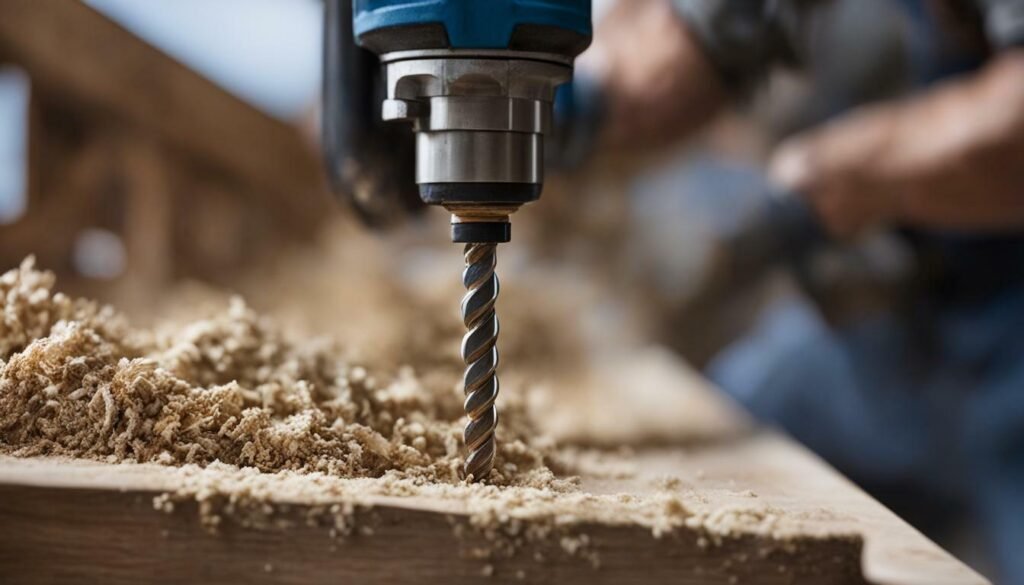

How Drilling Allows for Effective Chemical Treatment
By drilling holes, termite treatment professionals can deliver liquid chemical treatment directly into the ground, creating an effective barrier against termites. These holes are strategically placed in areas where termite activity or infestation is suspected, such as along the foundation, walls, or floors of a property. This targeted approach allows for precise application of the termiticide, ensuring maximum effectiveness in eradicating termites and preventing future infestations.
The drilling process involves the use of specialized equipment, such as drills and injectors, which enable professionals to access the subterranean areas where termites reside. This method allows the termiticide to reach the soil directly, targeting the termites’ nesting sites and foraging areas. It effectively eliminates termites by disrupting their colonies and creating a protective barrier that prevents their return.
Once the holes have been drilled and the termiticide has been injected, they are sealed off with putty or white cement to ensure that the treatment remains intact and effective. This meticulous sealing process is crucial to prevent any gaps or openings that termites could exploit to re-infest the property.
| Key Points: |
|---|
| Drilling allows for precise application of termiticide |
| Termiticide reaches the soil directly, targeting termites’ nesting sites |
| Sealing drilled holes after treatment is essential for long-term effectiveness |
The Importance of Professional Expertise
It is crucial to engage the services of a professional termite treatment specialist when drilling holes for termite control. Professional expertise ensures that the drilling process is conducted with precision and care, minimizing any potential damage to the property. Additionally, termite treatment professionals possess the necessary knowledge and experience to determine the most suitable treatment method for each property, taking into consideration the extent of the infestation, the type of termites present, and the specific conditions of the property.
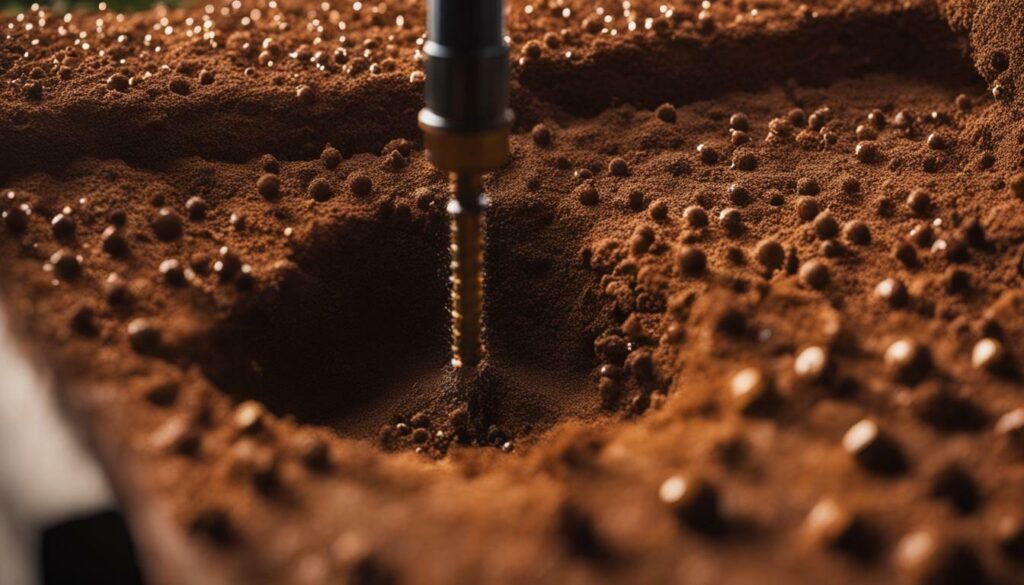

While drilling holes may be a necessary part of termite treatment, it is important to note that there are alternative methods available for those who prefer to avoid drilling. Chemical fumigation, the use of insecticides, or bait stations are viable options that can be explored in consultation with a professional termite treatment provider. These alternative methods can effectively control termite infestations without the need for drilling, offering flexibility for homeowners who may have concerns or specific preferences regarding the drilling process.
In conclusion, drilling holes for termite treatment is a vital step in ensuring effective control and prevention of termite infestations. By delivering liquid chemical treatment directly into the ground, professionals can create a strong barrier against termites, safeguarding homes and properties. The expertise of termite treatment professionals is crucial in choosing the right treatment method and executing the drilling process with precision, ultimately providing long-term protection against termites.
Alternative Termite Treatment Methods
If drilling holes is not preferred, there are alternative methods available for termite treatment, including chemical fumigation, the use of insecticides, or bait stations. These methods provide homeowners with effective options for protecting their properties from termite damage without the need for extensive drilling.
Chemical fumigation involves the use of specialized chemicals that are released into the structure’s enclosed space, creating a toxic atmosphere for termites. This method is highly effective in eradicating existing infestations and preventing future ones, as the gaseous fumigants penetrate deep into the wood and reach hidden termite colonies.
Insecticides, on the other hand, are applied directly to termite-infested areas, killing the insects on contact. This targeted approach provides a localized solution for eliminating termites without the need for drilling. It is particularly useful for spot treatments or when the termite activity is limited to specific areas.
Bait stations are another alternative method for termite treatment. These devices contain a slow-acting toxic substance that is attractive to termites. Once discovered, the termites carry the bait back to their colony, effectively spreading the poison and eliminating the entire termite population. Bait stations are often placed around the perimeter of the property, creating a protective barrier against future termite infestations.
Comparing Termite Treatment Methods
Here is a comparison table summarizing the different features of these alternative termite treatment methods:
| Termite Treatment Method | Application Process | Effectiveness | Targeted Areas |
|---|---|---|---|
| Chemical Fumigation | Gaseous chemicals released into enclosed spaces | Highly effective in eradicating infestations | Entire structure |
| Insecticides | Direct application to termite-infested areas | Targeted elimination of termites | Localized infestation areas |
| Bait Stations | Placement around the property perimeter | Eradicates entire termite colonies | Preventive measure against future infestations |
It is important to consult with termite treatment professionals to assess the specific needs of your property and determine the most suitable method for effective termite control. These experts will consider various factors such as the extent of the infestation, the structural layout, and your preferences to create a customized termite treatment plan that meets your requirements.


Rodding and Trenching for Subterranean Termite Treatment
Rodding and trenching are effective techniques for subterranean termite treatment, as they allow for precise delivery of termiticide into the soil. By creating small trenches or holes, termite treatment professionals can strategically place termiticide in areas where termites are likely to be present. This targeted approach ensures that the termiticide reaches the soil where termites live and helps to create a protective barrier against future infestations.
During the rodding process, a long tube or rod is inserted into the soil, allowing the termiticide to be injected directly into the ground. This method is particularly effective for treating areas where termites are actively feeding or nesting. The termiticide spreads through the soil, eliminating termites and preventing their return.
Trenching involves digging narrow trenches around the perimeter of the building or in areas of high termite activity. The termiticide is then poured into the trenches, saturating the soil and creating a barrier that termites cannot cross. This method is especially useful for targeting specific areas where termites are entering the structure, such as along foundation walls.
By utilizing rodding and trenching methods for subterranean termite treatment, professionals can ensure that the termiticide is effectively distributed throughout the soil, providing long-lasting protection against termite infestations. Combining these techniques with regular inspections and preventive measures can help homeowners maintain a termite-free environment in their homes.


| Advantages of Rodding and Trenching for Subterranean Termite Treatment | Disadvantages of Rodding and Trenching for Subterranean Termite Treatment |
|---|---|
|
|
Drilling Holes in the Foundation for Termite Treatment
Drilling holes in the foundation is another termite treatment method that requires professional expertise to effectively eliminate termites and protect the structure. These holes are strategically drilled in the foundation walls, floors, and the ground surrounding the house to create access points for liquid chemical treatment. By injecting termiticide directly into the ground, this method forms a protective barrier against termites, preventing infestations and potential damage to your home.
When it comes to termite control, drilling holes in the foundation is crucial to ensure that the chemical treatment reaches its intended target. The holes are carefully positioned based on the severity of the infestation and the specific needs of your property. Professionals use specialized equipment to drill the holes at precise locations, ensuring the most effective distribution of the termiticide.
Once the termiticide is injected into the drilled holes, they are sealed off with putty or white cement to prevent any further termite activity. This comprehensive approach helps to eliminate existing termite colonies and provides long-term protection against future infestations. The expertise of professionals in drilling holes in the foundation is essential to guarantee a thorough and successful termite treatment process.
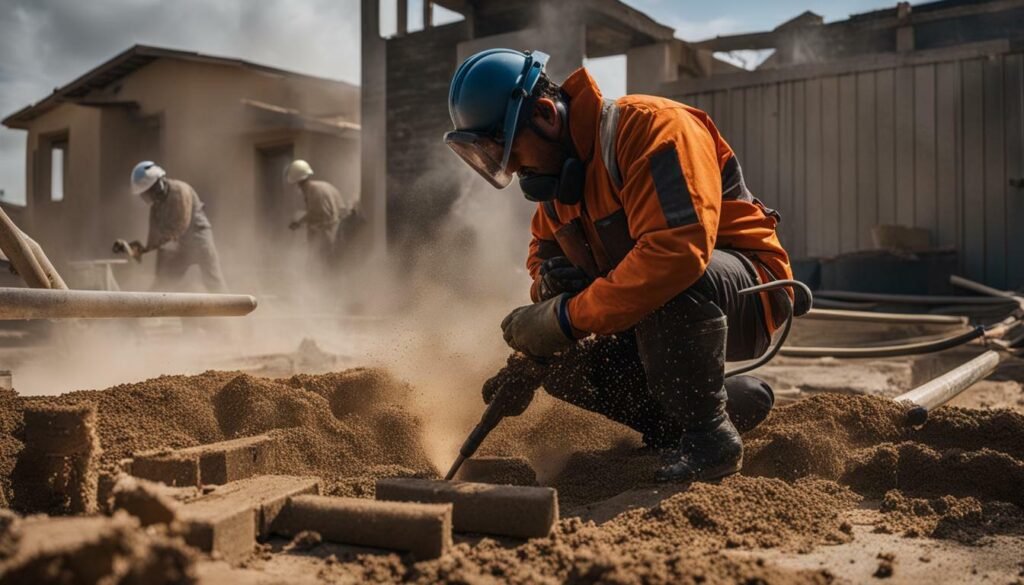

Remember, drilling holes in the foundation is just one of several termite treatment methods available. If you prefer not to have holes drilled, alternative options like chemical fumigation, insecticides, or bait stations can be considered. However, it is important to consult with termite treatment professionals to determine the most suitable method for your property. They can assess the extent of the infestation and recommend the most effective solution to protect your home from termites.
| Highlighted Points: |
|---|
| Drilling holes in the foundation is an effective method for termite treatment. |
| Professional expertise is necessary for precise drilling and injection of termiticide. |
| Sealing the drilled holes prevents further termite activity. |
| Alternative methods, such as chemical fumigation or bait stations, can be considered. |
The Effectiveness of Drilling, Rodding, and Trenching
The effectiveness of drilling, rodding, and trenching lies in their ability to apply termiticide directly into the soil, creating a barrier to prevent termite infestation. When termites come into contact with the treated soil, the chemical solution acts as a deterrent, effectively deterring termites from entering your home. This method of termite prevention is highly effective, providing long-term protection for your property.
Rodding and trenching are additional techniques used for subterranean termite treatment. By delivering termiticide directly into the soil, these methods ensure that the entire area is thoroughly treated, leaving no room for termites to thrive. This comprehensive approach is crucial for eradicating termite colonies and preventing their return.
It is important to consult with termite treatment professionals to determine the most suitable method for your property. They have the expertise and experience to assess the level of infestation and recommend the most effective course of action. By relying on their knowledge, you can ensure that your termite treatment plan is tailored to your specific needs, maximizing its effectiveness.
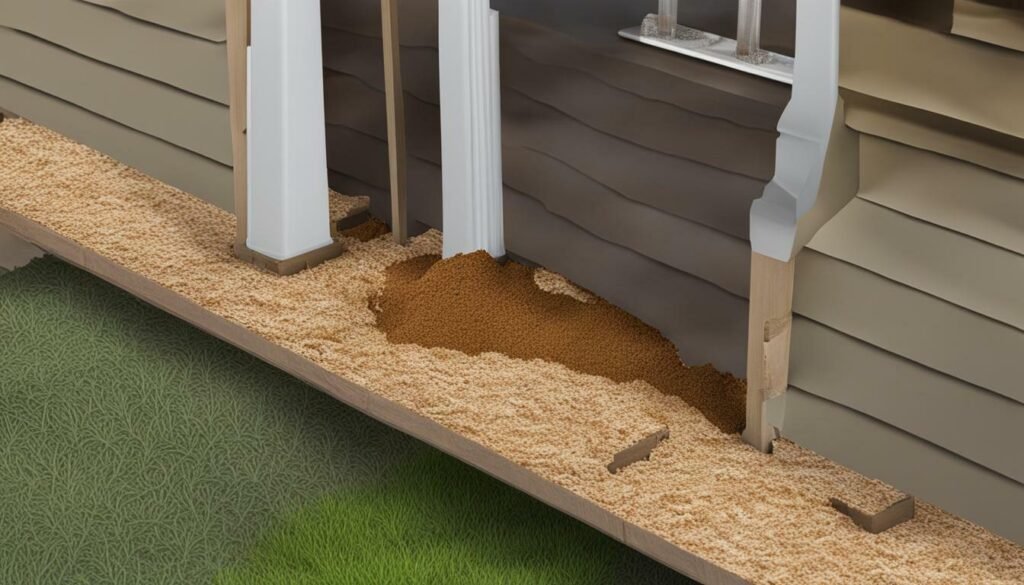

| Termite Treatment Method | Advantages |
|---|---|
| Drilling, Rodding, and Trenching | Direct application of termiticide into the soil creates a barrier against termites |
| Chemical Fumigation | Effective for large-scale termite infestations |
| Insecticides | Immediate termite control with residual effects |
| Bait Stations | Non-intrusive method that targets termite colonies |
While drilling holes in the foundation may be necessary for effective termite treatment, it is essential to rely on professional expertise. They have the specialized equipment and knowledge to handle the drilling process without causing any structural damage to your property. Properly sealed holes after treatment also prevent future termite damage, ensuring long-term protection for your home.
Considering Alternative Termite Treatment Methods
When it comes to termite treatment, it is crucial to consult with professionals who can recommend the most suitable method based on the specific needs of your property. While drilling holes is a common and effective method, there are alternative treatment options available. These alternatives can be useful in situations where drilling is not preferred or feasible.
Chemical fumigation is one such alternative. This method involves treating the entire structure with gaseous pesticides, which penetrate the wood and eliminate termites. It is a comprehensive solution that can eradicate termites in hard-to-reach areas. Additionally, insecticides can be applied directly to infested areas or used as a preventive measure to create a barrier against termites.
Bait stations are another alternative worth considering. These stations contain toxins that are ingested by termites and spread throughout the colony, effectively eliminating the entire population. This method is particularly useful for termite monitoring and control in areas where drilling may not be suitable.
When evaluating alternative treatment methods, it is important to weigh the pros and cons of each option. Factors such as the severity of the infestation, the location of the termite activity, and the specific needs of your property should be taken into account. Consulting with professionals experienced in termite control will ensure that you make an informed decision and choose the most suitable treatment method for your home.
Termite Treatment Options Comparison:
| Methods | Advantages | Disadvantages |
|---|---|---|
| Drilling and Chemical Treatment | Effective, long-term protection. Direct application of termiticide into the ground. | Requires drilling, potential cosmetic damage to walls or floors. |
| Chemical Fumigation | Comprehensive solution, eliminates termites in hard-to-reach areas. | May require temporary evacuation during treatment. |
| Use of Insecticides | Direct application, can be used preventively against future infestations. | May require repeated treatments, limited effectiveness for large infestations. |
| Bait Stations | Targets entire termite colony, effective for monitoring and control in non-drilling situations. | Slower elimination process, requires regular monitoring and maintenance. |


The Process of Hole Sealing After Treatment
After the termite treatment process, the drilled holes are sealed off using putty or white cement to prevent any potential termite damage in the future. This crucial step ensures that the treated areas are protected from further termite infestation and provides long-term security for your home. By effectively sealing the holes, you create a barrier that helps keep termites at bay, maintaining the integrity of your property.
Sealing the drilled holes is a meticulous process that requires attention to detail. The putty or white cement used is carefully applied to completely cover the holes, ensuring no gaps or openings are left behind. This ensures that termites cannot enter through these openings and cause damage to the treated areas. It is important to hire professionals who specialize in termite treatment to ensure that the hole sealing process is done correctly and effectively.
By sealing the drilled holes after termite treatment, you are taking an important step in preventing future termite damage. This proactive measure adds an extra layer of protection to your home, giving you peace of mind knowing that your property is safeguarded against these destructive pests. Consulting with professionals who have expertise in termite treatment is essential to ensure that the hole sealing process is carried out properly, providing long-lasting termite control for your home.
In summary, the process of hole sealing after termite treatment is a vital step in protecting your home from termites. By properly sealing the drilled holes with putty or white cement, you create a barrier that prevents termites from reinfesting the treated areas. This preventive measure adds an extra layer of security, ensuring that your property remains termite-free. Consulting with professionals who specialize in termite treatment is crucial to ensure the effectiveness of the hole sealing process and to provide long-term termite control for your home.
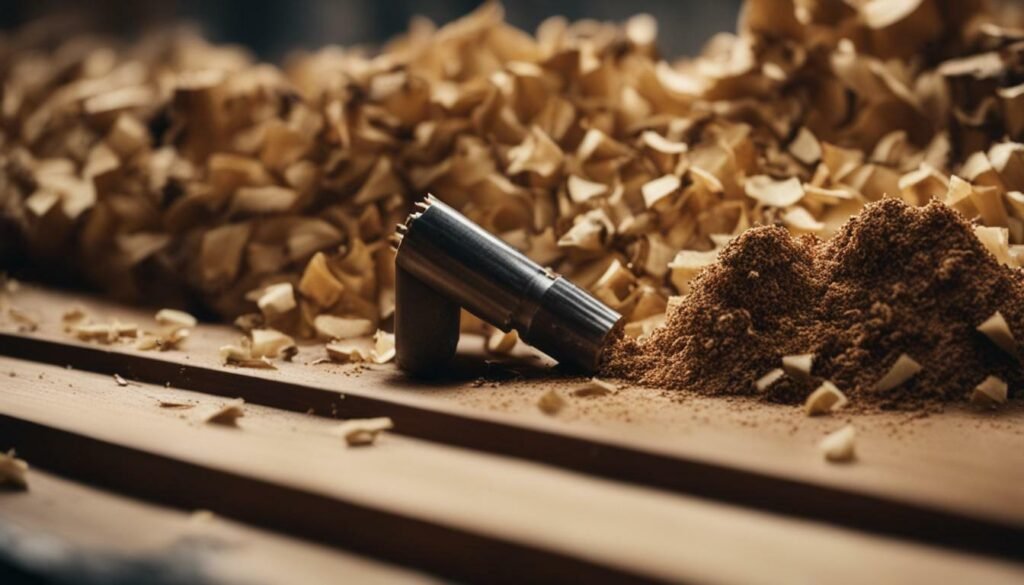

Exploring Chemical Treatment Options
Liquid chemical treatments like borax and formaldehyde are commonly utilized to effectively eliminate termites and protect your home from potential damage. These treatments are widely recognized for their efficacy in controlling termite infestations and preventing further destruction. When it comes to termite treatment, it is crucial to choose the right chemical solutions that can provide long-lasting protection for your property.
The use of borax, also known as sodium borate, is a popular choice in termite control. Borax is a natural mineral that disrupts the termites’ digestive system, leading to their eventual demise. It not only eliminates existing termites but also acts as a preventative measure, deterring future infestations. Borax is considered a safe and environmentally-friendly option, making it an ideal choice for homeowners.
Formaldehyde, another commonly used liquid chemical treatment, is highly effective in eradicating termites. It works by disrupting the termites’ respiratory system, causing their eventual death. Formaldehyde is particularly useful in treating wood structures, as it penetrates deep into the material, leaving no space for termite activity. However, it is important to note that formaldehyde is a strong chemical and should be handled and applied by professionals using the necessary safety precautions.
| Treatment Option | Advantages | Disadvantages |
|---|---|---|
| Borax | Safe for humans and pets, environmentally-friendly | May require multiple applications, slower acting compared to other chemicals |
| Formaldehyde | Highly effective, penetrates wood structures deeply | Strong chemical, requires professional handling |
When considering chemical treatment options for termite control, it is advisable to consult with a professional pest control company. They can assess the severity of the infestation and recommend the most suitable treatment method for your specific situation. Whether you opt for borax, formaldehyde, or any other liquid chemical treatment, it is essential to prioritize the safety and well-being of your home and its occupants.
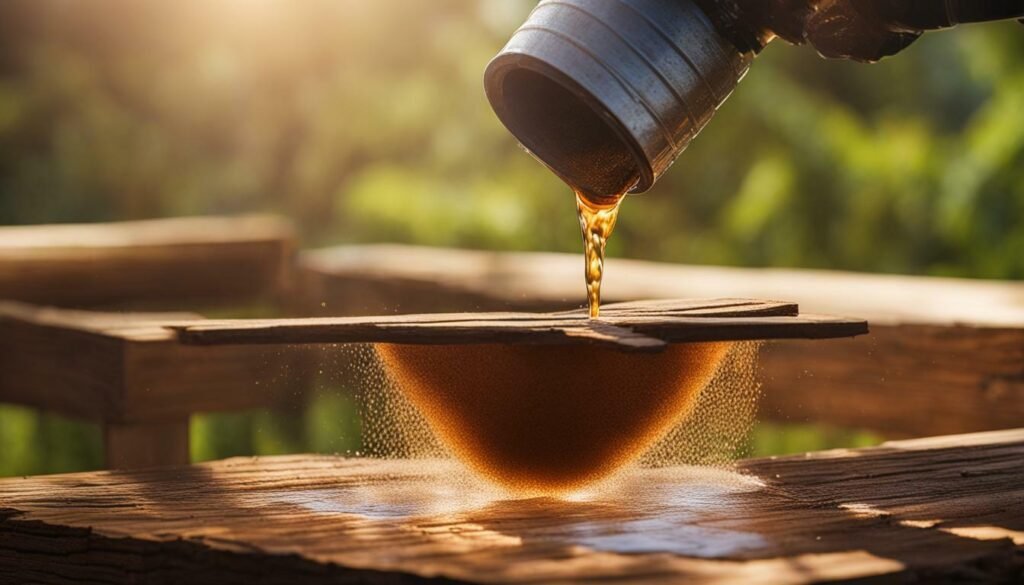

The Importance of Professional Expertise
It is essential to rely on the expertise of termite treatment professionals who possess the knowledge and experience to effectively eliminate termites and protect your home. These professionals understand the behavior of termites and can accurately identify the extent of infestation, allowing them to devise the most suitable treatment plan for your property.
Termite treatment often involves drilling holes in walls, floors, and the ground around the house. These holes serve as access points for injecting liquid chemical treatment into the ground, creating a protective barrier against termites. Professionals have the expertise to determine the precise locations for drilling to ensure maximum efficacy and minimal disruption to your home.
The process of drilling holes in concrete around the foundation requires specialized skills and equipment. Professionals utilize their expertise to carefully execute this method, minimizing potential damage to the structure while effectively treating termite infestations. Trusting professionals ensures that the treatment is carried out safely and efficiently, giving you peace of mind that your home is protected.
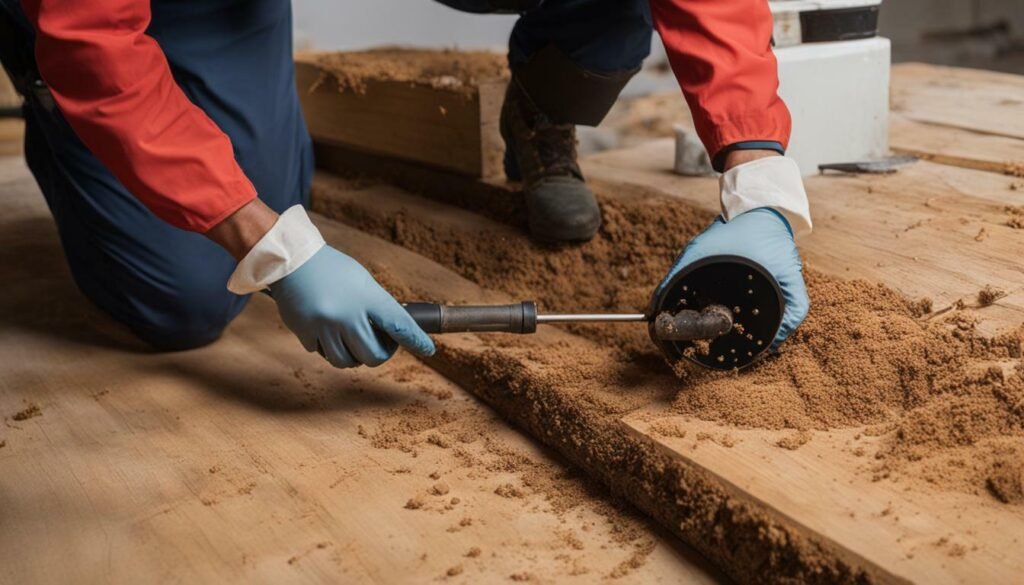

When it comes to termite treatment, the knowledge and experience of professionals are invaluable. They stay up to date with the latest treatment methods and products, ensuring that they employ the most effective strategies to eliminate termites. By relying on their expertise, you can rest assured that your home is in capable hands.
Benefits of Professional Expertise:
- Accurate identification of termite infestation
- Effective treatment plans tailored to your property
- Precise drilling techniques for maximum efficacy
- Minimized damage to the structure
- Utilization of the latest treatment methods and products
By partnering with termite treatment professionals, you can safeguard your home from the destructive effects of termites. Their expertise ensures that the treatment is carried out effectively, providing long-term protection and peace of mind for you and your family.
Conclusion
Understanding why drilling holes for termite treatment is necessary can help you make informed decisions to protect your home from termite damage.
When it comes to termite control, drilling holes in walls, floors, and the ground around your house is a crucial step. These holes allow professionals to inject liquid chemical treatment directly into the ground, creating a barrier against termites and preventing future infestations. The injected chemicals, such as borax and formaldehyde, effectively protect your home from these destructive pests. After treatment, the drilled holes are sealed off with putty or white cement to ensure the prevention of future termite damage.
If drilling holes is not your preferred method of termite treatment, there are alternative options available. Chemical fumigation, insecticides, and bait stations are commonly used as non-drilling alternatives. These methods can also be effective in controlling termites. Additionally, rodding and trenching techniques are employed for subterranean termite treatment, where termiticide is delivered directly into the soil. However, it’s essential to note that drilling holes in the concrete around the foundation requires professional expertise to ensure proper application and protection.
Consulting with termite treatment professionals is crucial in determining the most suitable method for your property. They have the knowledge and experience to assess the extent of infestation and recommend the most effective treatment approach. By utilizing their professional expertise, you can safeguard your home and prevent costly termite damage in the long run.
FAQ
Q: Why do they drill holes for termite treatment?
A: Drilling holes is necessary to inject liquid chemical treatment into the ground, creating a barrier against termites and protecting your home from termite damage.
Q: What is the importance of drilling for termite treatment?
A: Drilling holes in the termite treatment process offers long-term termite control and helps prevent future infestation.
Q: How does drilling allow for effective chemical treatment?
A: By drilling holes, professionals can directly inject liquid chemical treatment into the ground, creating a barrier against termites and ensuring effective termite control.
Q: What are the alternative termite treatment methods?
A: If drilling holes is not preferred, alternative termite treatment methods include chemical fumigation, the use of insecticides, or bait stations.
Q: What are rodding and trenching methods for subterranean termite treatment?
A: Rodding and trenching involve delivering termiticide into the soil, providing effective subterranean termite treatment.
Q: How does drilling holes in the foundation help in termite treatment?
A: Drilling holes in the foundation is a termite treatment method that requires professional expertise and helps protect your home from termite infestation.
Q: Are drilling, rodding, and trenching methods effective for termite prevention?
A: Yes, drilling, rodding, and trenching methods are effective for termite prevention as they allow direct application of termiticide into the soil, creating a barrier against termites.
Q: How do I determine the most suitable termite treatment method?
A: It is important to consult with professionals to determine the most suitable termite treatment method for your property.
Q: What is the process of sealing drilled holes after termite treatment?
A: After termite treatment, the drilled holes are sealed off with putty or white cement to prevent future termite damage.
Q: What are the liquid chemical treatment options for termite control?
A: Commonly used liquid chemical treatment options for termite control include borax and formaldehyde.
Q: Why is professional expertise important in termite treatment?
A: Seeking professional expertise ensures effective and reliable termite treatment, providing optimal results for protecting your home.
Source Links
- https://www.mightymitetermite.com/blog/termite-treatment-application-rodding-vs-drilling/
- https://www.zippests.com/why-do-they-drill-holes-for-termite-treatment/
- https://pestquit.in/why-do-pest-control-professionals-drill-holes-for-termite-treatment/amp/
Your Expert in Animal Control and Extermination. Trust our experience for humane, effective pest management, protecting your property and ensuring peace of mind with Michael S.





